Business Law Report: English Legal System, Regulations, and Solutions
VerifiedAdded on 2020/07/22
|18
|6208
|157
Report
AI Summary
This Business Law report provides a detailed analysis of the English legal system, its structure, and the duties of legal authorities in law-making. It explores the effectiveness of the system in the context of current reforms, examining the relationships between regulations, legislations, and standards. The report delves into the impact of contract and employment law on businesses, including the responsibilities of directors and the employer-employee relationship. It also considers legal solutions to organizational problems, such as company legislation and capital raising, and evaluates the positive and negative impacts of these solutions. Furthermore, the report covers the concept of Alternative Dispute Resolution (ADR), recommending alternative solutions to business problems and comparing their effectiveness.
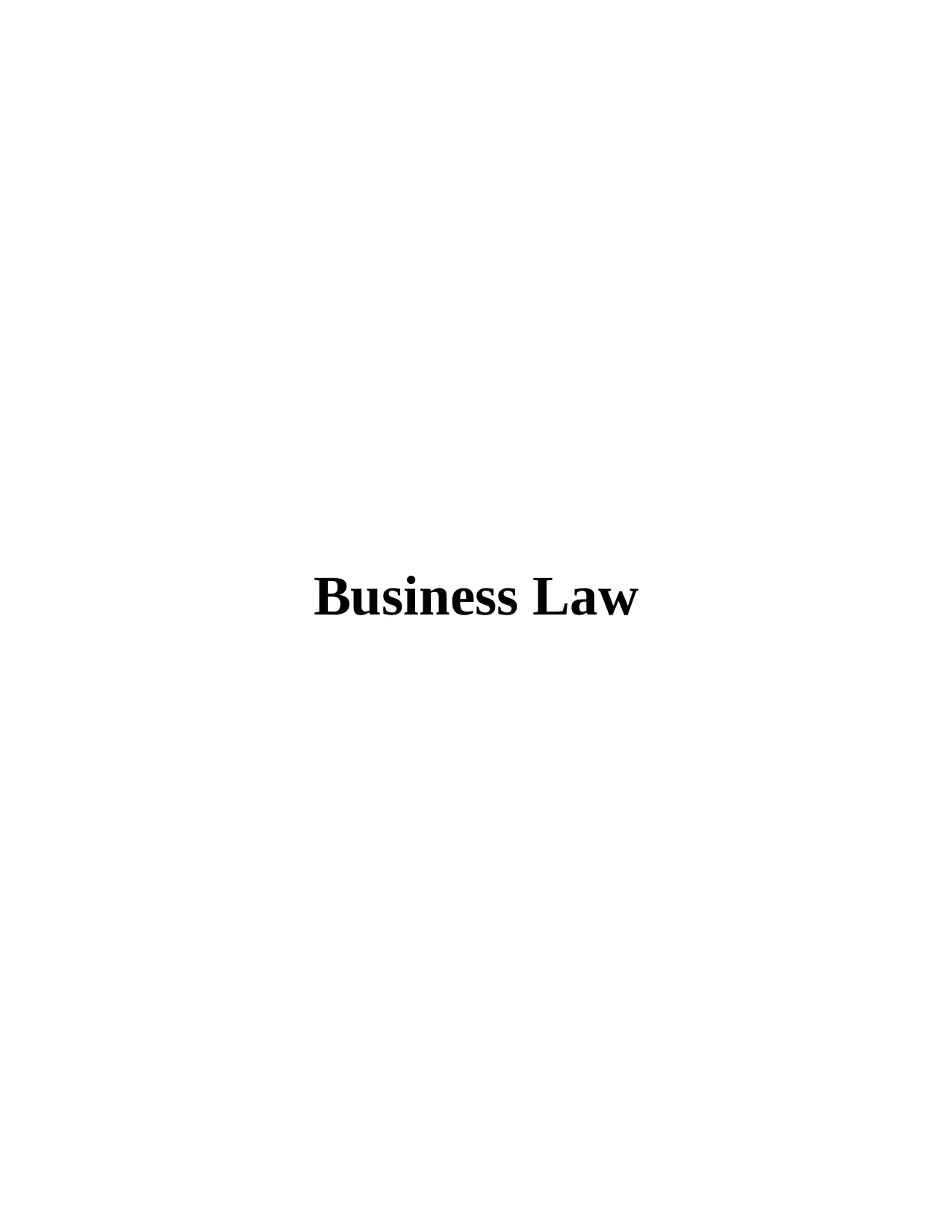
Business Law
Paraphrase This Document
Need a fresh take? Get an instant paraphrase of this document with our AI Paraphraser

Table of Contents
INTRODUCTION...........................................................................................................................1
TASK 1 ...........................................................................................................................................1
P1 Explain the structure of English legal system ..................................................................1
P 2 The duties of legal authority in law making ....................................................................4
M1 Effectiveness of English legal system in context of current reforms...............................5
TASK 2............................................................................................................................................6
P3 A) legislation and legal responsibilities............................................................................6
The relationship between regulations, legislations and standards.....................................6
Implication and impact of various legislations .................................................................6
P3 B) Explaining the way relevant contract and Employment Law Impact the Business.....7
The responsibilities of directors and delegation of tasks..................................................8
The way Employer and employee relationship interact with employment Law.............................8
M2 Differentiating and analysing the potential effect of regulations, legislations as well as
standards ................................................................................................................................9
P4 Suitable legal solution to problem faced by organisation.................................................9
Considering the application of company legislation in forming organisation, raising capital,
correlation of pay and performance.................................................................................10
P5 Explanation related to the above solutions .....................................................................11
1. In case of Calvin........................................................................................................................11
M3 Positive and negative impact of legal solution .............................................................12
TASK 4..........................................................................................................................................12
P6 A) Concept of Alternative Dispute Resolution (ADR)...................................................12
P6 B) Recommending an alternative solution to business problem.....................................12
M4 Compare and contrast thse effectiveness of two different recommendations................13
CONCLUSION..............................................................................................................................14
REFERENCES..............................................................................................................................15
INTRODUCTION...........................................................................................................................1
TASK 1 ...........................................................................................................................................1
P1 Explain the structure of English legal system ..................................................................1
P 2 The duties of legal authority in law making ....................................................................4
M1 Effectiveness of English legal system in context of current reforms...............................5
TASK 2............................................................................................................................................6
P3 A) legislation and legal responsibilities............................................................................6
The relationship between regulations, legislations and standards.....................................6
Implication and impact of various legislations .................................................................6
P3 B) Explaining the way relevant contract and Employment Law Impact the Business.....7
The responsibilities of directors and delegation of tasks..................................................8
The way Employer and employee relationship interact with employment Law.............................8
M2 Differentiating and analysing the potential effect of regulations, legislations as well as
standards ................................................................................................................................9
P4 Suitable legal solution to problem faced by organisation.................................................9
Considering the application of company legislation in forming organisation, raising capital,
correlation of pay and performance.................................................................................10
P5 Explanation related to the above solutions .....................................................................11
1. In case of Calvin........................................................................................................................11
M3 Positive and negative impact of legal solution .............................................................12
TASK 4..........................................................................................................................................12
P6 A) Concept of Alternative Dispute Resolution (ADR)...................................................12
P6 B) Recommending an alternative solution to business problem.....................................12
M4 Compare and contrast thse effectiveness of two different recommendations................13
CONCLUSION..............................................................................................................................14
REFERENCES..............................................................................................................................15
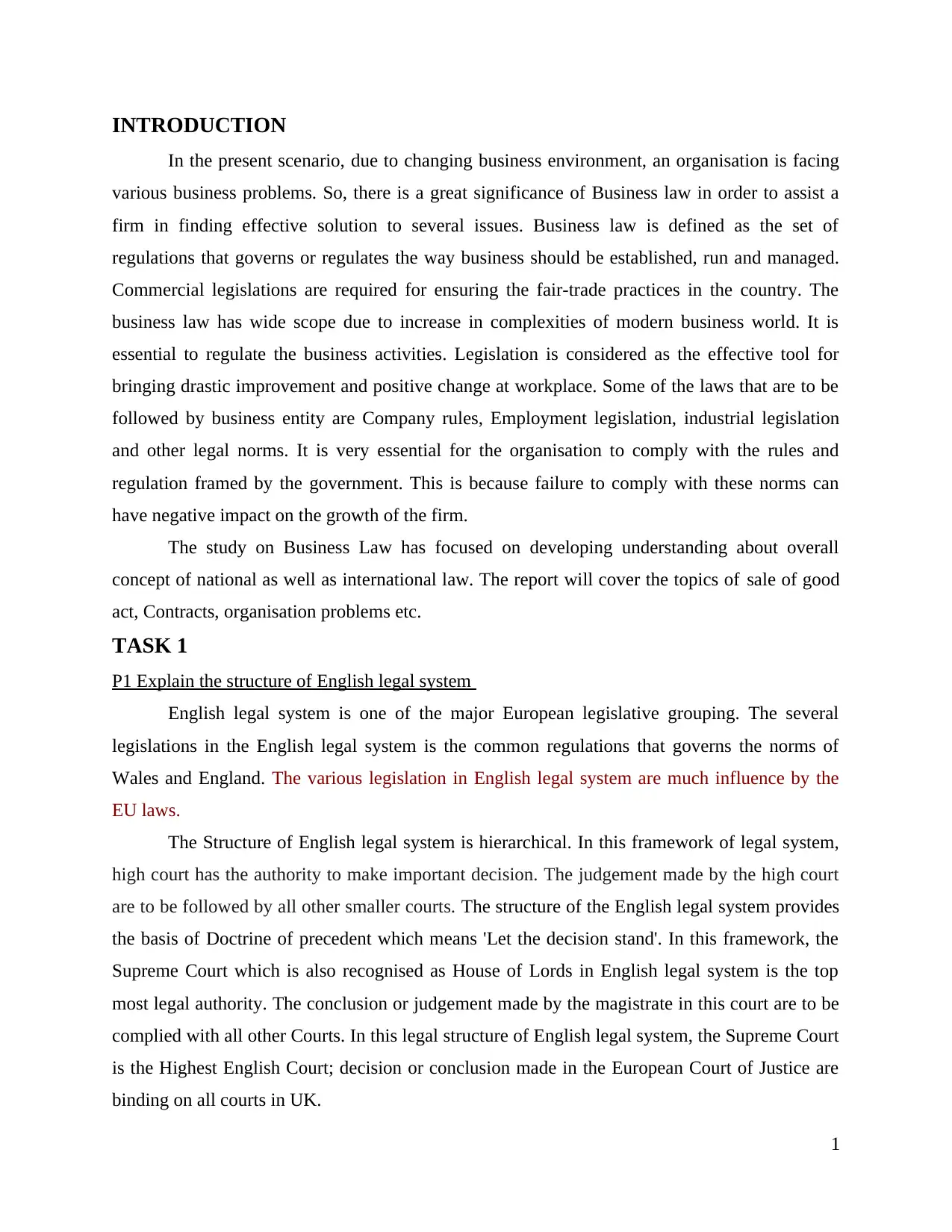
INTRODUCTION
In the present scenario, due to changing business environment, an organisation is facing
various business problems. So, there is a great significance of Business law in order to assist a
firm in finding effective solution to several issues. Business law is defined as the set of
regulations that governs or regulates the way business should be established, run and managed.
Commercial legislations are required for ensuring the fair-trade practices in the country. The
business law has wide scope due to increase in complexities of modern business world. It is
essential to regulate the business activities. Legislation is considered as the effective tool for
bringing drastic improvement and positive change at workplace. Some of the laws that are to be
followed by business entity are Company rules, Employment legislation, industrial legislation
and other legal norms. It is very essential for the organisation to comply with the rules and
regulation framed by the government. This is because failure to comply with these norms can
have negative impact on the growth of the firm.
The study on Business Law has focused on developing understanding about overall
concept of national as well as international law. The report will cover the topics of sale of good
act, Contracts, organisation problems etc.
TASK 1
P1 Explain the structure of English legal system
English legal system is one of the major European legislative grouping. The several
legislations in the English legal system is the common regulations that governs the norms of
Wales and England. The various legislation in English legal system are much influence by the
EU laws.
The Structure of English legal system is hierarchical. In this framework of legal system,
high court has the authority to make important decision. The judgement made by the high court
are to be followed by all other smaller courts. The structure of the English legal system provides
the basis of Doctrine of precedent which means 'Let the decision stand'. In this framework, the
Supreme Court which is also recognised as House of Lords in English legal system is the top
most legal authority. The conclusion or judgement made by the magistrate in this court are to be
complied with all other Courts. In this legal structure of English legal system, the Supreme Court
is the Highest English Court; decision or conclusion made in the European Court of Justice are
binding on all courts in UK.
1
In the present scenario, due to changing business environment, an organisation is facing
various business problems. So, there is a great significance of Business law in order to assist a
firm in finding effective solution to several issues. Business law is defined as the set of
regulations that governs or regulates the way business should be established, run and managed.
Commercial legislations are required for ensuring the fair-trade practices in the country. The
business law has wide scope due to increase in complexities of modern business world. It is
essential to regulate the business activities. Legislation is considered as the effective tool for
bringing drastic improvement and positive change at workplace. Some of the laws that are to be
followed by business entity are Company rules, Employment legislation, industrial legislation
and other legal norms. It is very essential for the organisation to comply with the rules and
regulation framed by the government. This is because failure to comply with these norms can
have negative impact on the growth of the firm.
The study on Business Law has focused on developing understanding about overall
concept of national as well as international law. The report will cover the topics of sale of good
act, Contracts, organisation problems etc.
TASK 1
P1 Explain the structure of English legal system
English legal system is one of the major European legislative grouping. The several
legislations in the English legal system is the common regulations that governs the norms of
Wales and England. The various legislation in English legal system are much influence by the
EU laws.
The Structure of English legal system is hierarchical. In this framework of legal system,
high court has the authority to make important decision. The judgement made by the high court
are to be followed by all other smaller courts. The structure of the English legal system provides
the basis of Doctrine of precedent which means 'Let the decision stand'. In this framework, the
Supreme Court which is also recognised as House of Lords in English legal system is the top
most legal authority. The conclusion or judgement made by the magistrate in this court are to be
complied with all other Courts. In this legal structure of English legal system, the Supreme Court
is the Highest English Court; decision or conclusion made in the European Court of Justice are
binding on all courts in UK.
1
⊘ This is a preview!⊘
Do you want full access?
Subscribe today to unlock all pages.

Trusted by 1+ million students worldwide

The court of appeal is recognised to be at lowest to the supreme court in the hierarchical
structure. The structure is split between the criminal as well as civil divisions. The conclusion
drawn by both divisions is to be followed by lower courts. If in case, there is dispute between
two previous decisions taken, the tribunal may decide which decision or judgement to be
followed and which to be overruled. The existing judgement that has been overruled by the
Supreme Court that is the House of Lords, the court of appeal is required to comply with the
judgement made by superior court
(Bowie, 2017.) Divisional courts are located within the division of high court. The high court has
to accept the decision taken by upper courts. Other small courts that are at the lower position in
the hierarchical structure are as follows:
Crown Court- The various law suits, whose decision are not taken by the magistrate court
are transferred to the crown court. All the criminal cases are to be handled as well as
managed by this tribunal.
Country Tribunal- This court does not include Jury members in decision making
procedure. In this, Tribunal magistrate is only the person who has authority to make final
judgement.
High Court- The conclusion made by the judge in the high court are binding upon lower
judicature. The High Court is divided into three categories; these are: chancellor, queen
bench and family. In chancellor and family tribunal, the family matter, industrial disputes
as well as other issues faced by business are heard and decision is made by the magistrate
on the basis of evidence. While in queen bench division, the cases related to construction,
technology, administration, etc. are dealt by the court.
2
structure. The structure is split between the criminal as well as civil divisions. The conclusion
drawn by both divisions is to be followed by lower courts. If in case, there is dispute between
two previous decisions taken, the tribunal may decide which decision or judgement to be
followed and which to be overruled. The existing judgement that has been overruled by the
Supreme Court that is the House of Lords, the court of appeal is required to comply with the
judgement made by superior court
(Bowie, 2017.) Divisional courts are located within the division of high court. The high court has
to accept the decision taken by upper courts. Other small courts that are at the lower position in
the hierarchical structure are as follows:
Crown Court- The various law suits, whose decision are not taken by the magistrate court
are transferred to the crown court. All the criminal cases are to be handled as well as
managed by this tribunal.
Country Tribunal- This court does not include Jury members in decision making
procedure. In this, Tribunal magistrate is only the person who has authority to make final
judgement.
High Court- The conclusion made by the judge in the high court are binding upon lower
judicature. The High Court is divided into three categories; these are: chancellor, queen
bench and family. In chancellor and family tribunal, the family matter, industrial disputes
as well as other issues faced by business are heard and decision is made by the magistrate
on the basis of evidence. While in queen bench division, the cases related to construction,
technology, administration, etc. are dealt by the court.
2
Paraphrase This Document
Need a fresh take? Get an instant paraphrase of this document with our AI Paraphraser
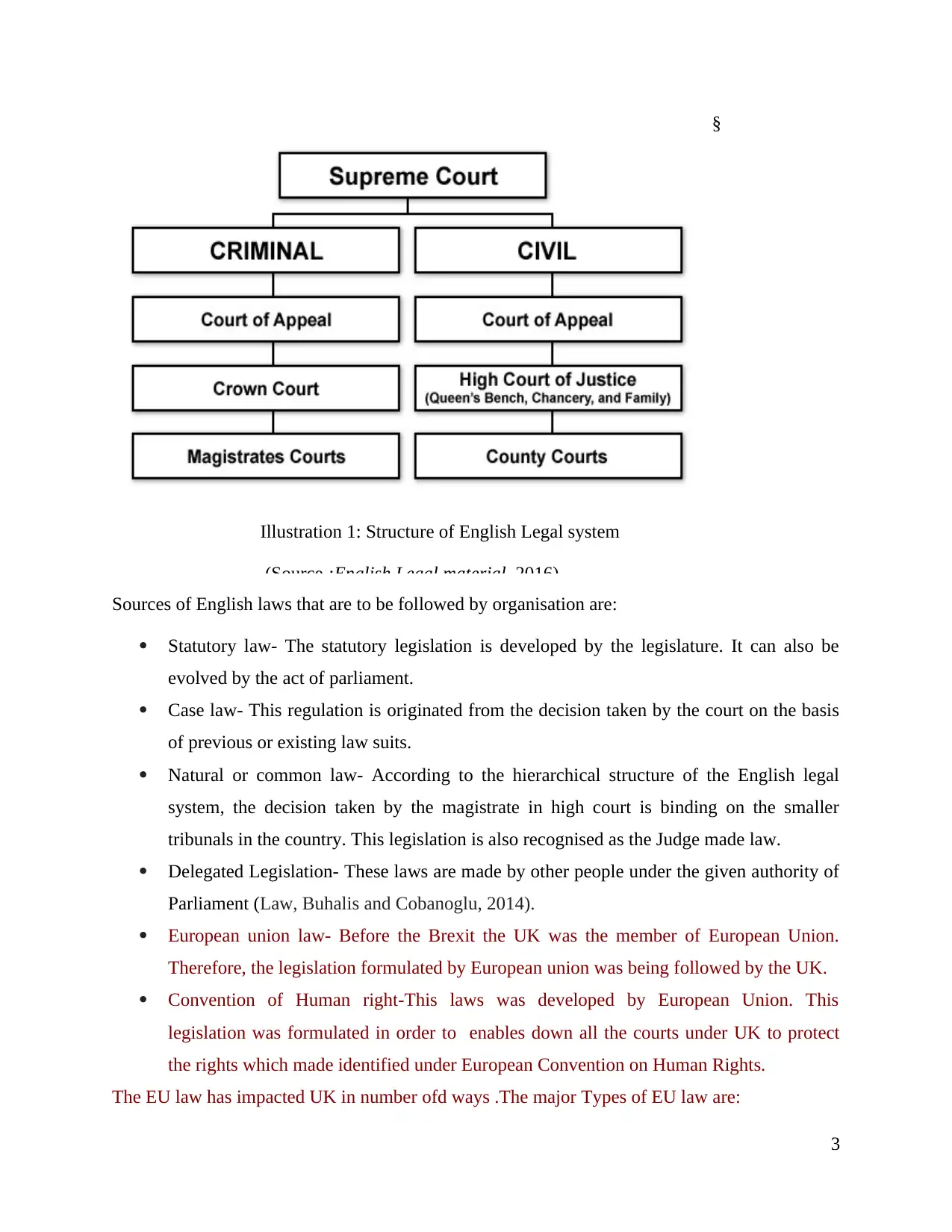
Illustration 1: Structure of English Legal system
(Source :English Legal material, 2016)
§
Sources of English laws that are to be followed by organisation are:
Statutory law- The statutory legislation is developed by the legislature. It can also be
evolved by the act of parliament.
Case law- This regulation is originated from the decision taken by the court on the basis
of previous or existing law suits.
Natural or common law- According to the hierarchical structure of the English legal
system, the decision taken by the magistrate in high court is binding on the smaller
tribunals in the country. This legislation is also recognised as the Judge made law.
Delegated Legislation- These laws are made by other people under the given authority of
Parliament (Law, Buhalis and Cobanoglu, 2014).
European union law- Before the Brexit the UK was the member of European Union.
Therefore, the legislation formulated by European union was being followed by the UK.
Convention of Human right-This laws was developed by European Union. This
legislation was formulated in order to enables down all the courts under UK to protect
the rights which made identified under European Convention on Human Rights.
The EU law has impacted UK in number ofd ways .The major Types of EU law are:
3
(Source :English Legal material, 2016)
§
Sources of English laws that are to be followed by organisation are:
Statutory law- The statutory legislation is developed by the legislature. It can also be
evolved by the act of parliament.
Case law- This regulation is originated from the decision taken by the court on the basis
of previous or existing law suits.
Natural or common law- According to the hierarchical structure of the English legal
system, the decision taken by the magistrate in high court is binding on the smaller
tribunals in the country. This legislation is also recognised as the Judge made law.
Delegated Legislation- These laws are made by other people under the given authority of
Parliament (Law, Buhalis and Cobanoglu, 2014).
European union law- Before the Brexit the UK was the member of European Union.
Therefore, the legislation formulated by European union was being followed by the UK.
Convention of Human right-This laws was developed by European Union. This
legislation was formulated in order to enables down all the courts under UK to protect
the rights which made identified under European Convention on Human Rights.
The EU law has impacted UK in number ofd ways .The major Types of EU law are:
3
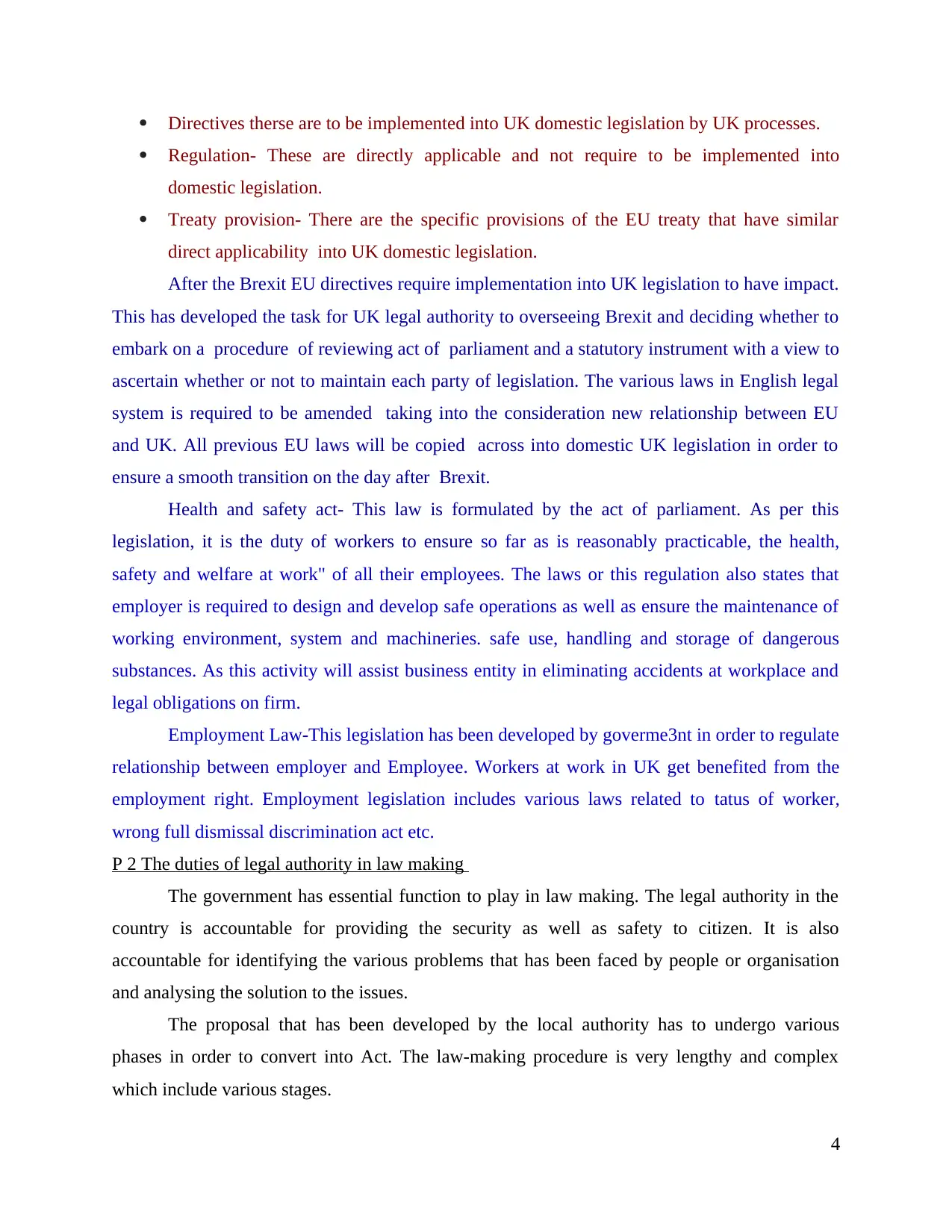
Directives therse are to be implemented into UK domestic legislation by UK processes.
Regulation- These are directly applicable and not require to be implemented into
domestic legislation.
Treaty provision- There are the specific provisions of the EU treaty that have similar
direct applicability into UK domestic legislation.
After the Brexit EU directives require implementation into UK legislation to have impact.
This has developed the task for UK legal authority to overseeing Brexit and deciding whether to
embark on a procedure of reviewing act of parliament and a statutory instrument with a view to
ascertain whether or not to maintain each party of legislation. The various laws in English legal
system is required to be amended taking into the consideration new relationship between EU
and UK. All previous EU laws will be copied across into domestic UK legislation in order to
ensure a smooth transition on the day after Brexit.
Health and safety act- This law is formulated by the act of parliament. As per this
legislation, it is the duty of workers to ensure so far as is reasonably practicable, the health,
safety and welfare at work" of all their employees. The laws or this regulation also states that
employer is required to design and develop safe operations as well as ensure the maintenance of
working environment, system and machineries. safe use, handling and storage of dangerous
substances. As this activity will assist business entity in eliminating accidents at workplace and
legal obligations on firm.
Employment Law-This legislation has been developed by goverme3nt in order to regulate
relationship between employer and Employee. Workers at work in UK get benefited from the
employment right. Employment legislation includes various laws related to tatus of worker,
wrong full dismissal discrimination act etc.
P 2 The duties of legal authority in law making
The government has essential function to play in law making. The legal authority in the
country is accountable for providing the security as well as safety to citizen. It is also
accountable for identifying the various problems that has been faced by people or organisation
and analysing the solution to the issues.
The proposal that has been developed by the local authority has to undergo various
phases in order to convert into Act. The law-making procedure is very lengthy and complex
which include various stages.
4
Regulation- These are directly applicable and not require to be implemented into
domestic legislation.
Treaty provision- There are the specific provisions of the EU treaty that have similar
direct applicability into UK domestic legislation.
After the Brexit EU directives require implementation into UK legislation to have impact.
This has developed the task for UK legal authority to overseeing Brexit and deciding whether to
embark on a procedure of reviewing act of parliament and a statutory instrument with a view to
ascertain whether or not to maintain each party of legislation. The various laws in English legal
system is required to be amended taking into the consideration new relationship between EU
and UK. All previous EU laws will be copied across into domestic UK legislation in order to
ensure a smooth transition on the day after Brexit.
Health and safety act- This law is formulated by the act of parliament. As per this
legislation, it is the duty of workers to ensure so far as is reasonably practicable, the health,
safety and welfare at work" of all their employees. The laws or this regulation also states that
employer is required to design and develop safe operations as well as ensure the maintenance of
working environment, system and machineries. safe use, handling and storage of dangerous
substances. As this activity will assist business entity in eliminating accidents at workplace and
legal obligations on firm.
Employment Law-This legislation has been developed by goverme3nt in order to regulate
relationship between employer and Employee. Workers at work in UK get benefited from the
employment right. Employment legislation includes various laws related to tatus of worker,
wrong full dismissal discrimination act etc.
P 2 The duties of legal authority in law making
The government has essential function to play in law making. The legal authority in the
country is accountable for providing the security as well as safety to citizen. It is also
accountable for identifying the various problems that has been faced by people or organisation
and analysing the solution to the issues.
The proposal that has been developed by the local authority has to undergo various
phases in order to convert into Act. The law-making procedure is very lengthy and complex
which include various stages.
4
⊘ This is a preview!⊘
Do you want full access?
Subscribe today to unlock all pages.

Trusted by 1+ million students worldwide

In the first phase, the problems that has been faced by the majority of business unit are
identified by the government. In the next phase, the legal authority has the responsibility to find
the solution to several issues that are being faced by the majority of organisation. In the third
phase, the proposal is drafted or designed by the local body which consists of highlighted issues
and solution for the same.
In the fourth phase, the proposal is presented in front of lower authorities at regional and
state level for the approval. When the proposal gets approved at this level, then it is to be
presented before the common chamber for further approval.
If the proposal is passed by the common chamber, then it is to be presented for first
reading in the Chamber.
In the next phase, the legal authority has to make changes in the bill as suggested by the
members in the Supreme Court or chamber. At this stage, the debate can be facilitated in the
context of the bill for measuring the reliability, flexibility, applicability and viability of the bill.
Then after the proposal is forwarded to other chamber for detail evaluation. Then it is conferred
for the next reading.
In the final phase, after all the amendment is made by the government, the bill is
presented in the Court for final reading. This is the phase at which the decision related to the
acceptance or rejection of the bill is made by the court.
After the bill get converted into the act, it is role of the government to support court in
implementing the legislation and communicating the detail of the law to the public (Rutledge,
2014)
M1 Effectiveness of English legal system in context of current reforms
The legal reforms are based on the fact that the legal institutions play important and
independent role in the formulation of law and development of the country. As the decision
related to the acceptance or rejection of the bill is totally dependent on the Parliament. The
judgement made by the House of Lords are according to the communities, people and country.
The purpose of various legislation in the English law system is to bring economic stability,
controlling price inflation, fostering country development procedure. Due to development in the
reforms, the focus of the laws has change to the rule of game of society. These rules or regulation
of the game consists of specific standards that are to be followed by the organisation. The recent
5
identified by the government. In the next phase, the legal authority has the responsibility to find
the solution to several issues that are being faced by the majority of organisation. In the third
phase, the proposal is drafted or designed by the local body which consists of highlighted issues
and solution for the same.
In the fourth phase, the proposal is presented in front of lower authorities at regional and
state level for the approval. When the proposal gets approved at this level, then it is to be
presented before the common chamber for further approval.
If the proposal is passed by the common chamber, then it is to be presented for first
reading in the Chamber.
In the next phase, the legal authority has to make changes in the bill as suggested by the
members in the Supreme Court or chamber. At this stage, the debate can be facilitated in the
context of the bill for measuring the reliability, flexibility, applicability and viability of the bill.
Then after the proposal is forwarded to other chamber for detail evaluation. Then it is conferred
for the next reading.
In the final phase, after all the amendment is made by the government, the bill is
presented in the Court for final reading. This is the phase at which the decision related to the
acceptance or rejection of the bill is made by the court.
After the bill get converted into the act, it is role of the government to support court in
implementing the legislation and communicating the detail of the law to the public (Rutledge,
2014)
M1 Effectiveness of English legal system in context of current reforms
The legal reforms are based on the fact that the legal institutions play important and
independent role in the formulation of law and development of the country. As the decision
related to the acceptance or rejection of the bill is totally dependent on the Parliament. The
judgement made by the House of Lords are according to the communities, people and country.
The purpose of various legislation in the English law system is to bring economic stability,
controlling price inflation, fostering country development procedure. Due to development in the
reforms, the focus of the laws has change to the rule of game of society. These rules or regulation
of the game consists of specific standards that are to be followed by the organisation. The recent
5
Paraphrase This Document
Need a fresh take? Get an instant paraphrase of this document with our AI Paraphraser
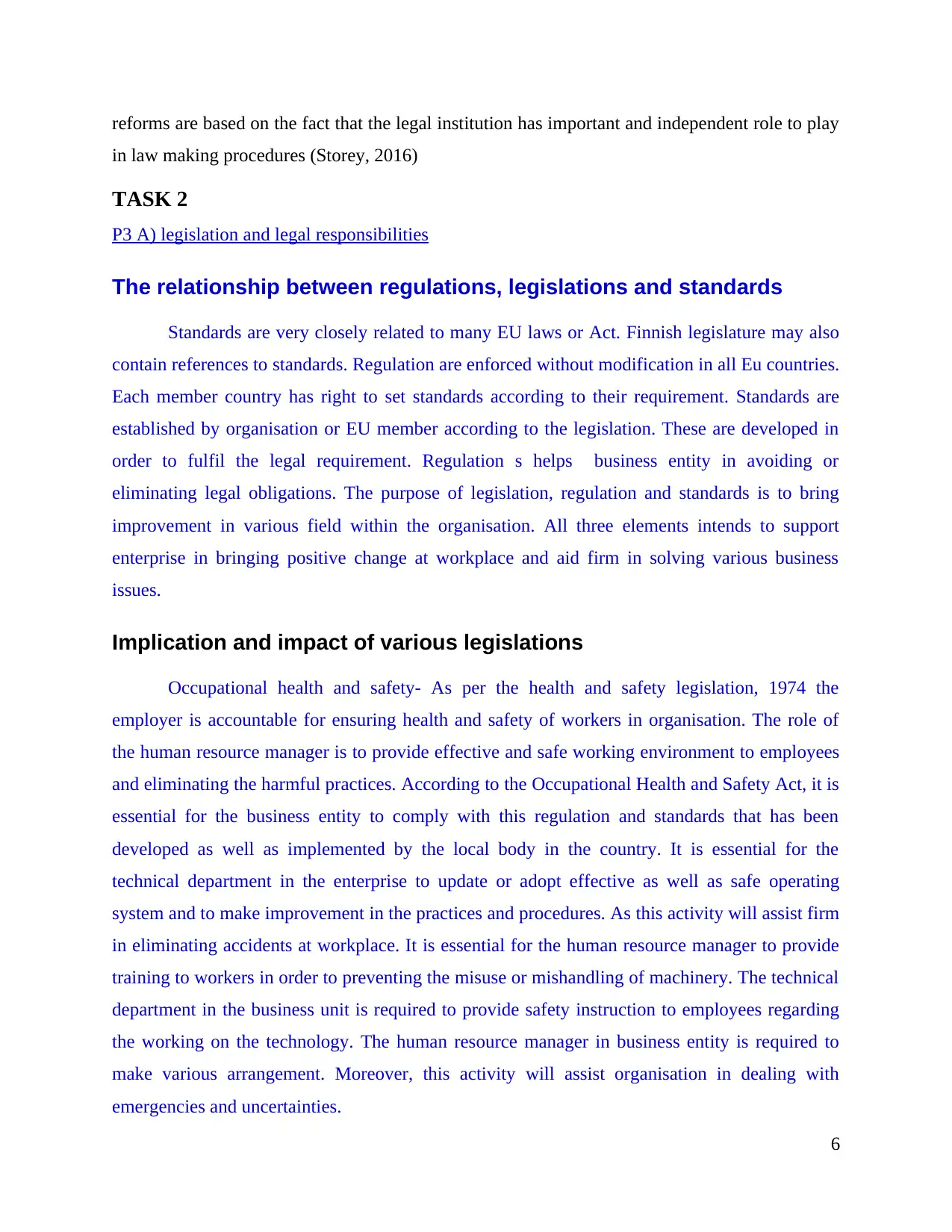
reforms are based on the fact that the legal institution has important and independent role to play
in law making procedures (Storey, 2016)
TASK 2
P3 A) legislation and legal responsibilities
The relationship between regulations, legislations and standards
Standards are very closely related to many EU laws or Act. Finnish legislature may also
contain references to standards. Regulation are enforced without modification in all Eu countries.
Each member country has right to set standards according to their requirement. Standards are
established by organisation or EU member according to the legislation. These are developed in
order to fulfil the legal requirement. Regulation s helps business entity in avoiding or
eliminating legal obligations. The purpose of legislation, regulation and standards is to bring
improvement in various field within the organisation. All three elements intends to support
enterprise in bringing positive change at workplace and aid firm in solving various business
issues.
Implication and impact of various legislations
Occupational health and safety- As per the health and safety legislation, 1974 the
employer is accountable for ensuring health and safety of workers in organisation. The role of
the human resource manager is to provide effective and safe working environment to employees
and eliminating the harmful practices. According to the Occupational Health and Safety Act, it is
essential for the business entity to comply with this regulation and standards that has been
developed as well as implemented by the local body in the country. It is essential for the
technical department in the enterprise to update or adopt effective as well as safe operating
system and to make improvement in the practices and procedures. As this activity will assist firm
in eliminating accidents at workplace. It is essential for the human resource manager to provide
training to workers in order to preventing the misuse or mishandling of machinery. The technical
department in the business unit is required to provide safety instruction to employees regarding
the working on the technology. The human resource manager in business entity is required to
make various arrangement. Moreover, this activity will assist organisation in dealing with
emergencies and uncertainties.
6
in law making procedures (Storey, 2016)
TASK 2
P3 A) legislation and legal responsibilities
The relationship between regulations, legislations and standards
Standards are very closely related to many EU laws or Act. Finnish legislature may also
contain references to standards. Regulation are enforced without modification in all Eu countries.
Each member country has right to set standards according to their requirement. Standards are
established by organisation or EU member according to the legislation. These are developed in
order to fulfil the legal requirement. Regulation s helps business entity in avoiding or
eliminating legal obligations. The purpose of legislation, regulation and standards is to bring
improvement in various field within the organisation. All three elements intends to support
enterprise in bringing positive change at workplace and aid firm in solving various business
issues.
Implication and impact of various legislations
Occupational health and safety- As per the health and safety legislation, 1974 the
employer is accountable for ensuring health and safety of workers in organisation. The role of
the human resource manager is to provide effective and safe working environment to employees
and eliminating the harmful practices. According to the Occupational Health and Safety Act, it is
essential for the business entity to comply with this regulation and standards that has been
developed as well as implemented by the local body in the country. It is essential for the
technical department in the enterprise to update or adopt effective as well as safe operating
system and to make improvement in the practices and procedures. As this activity will assist firm
in eliminating accidents at workplace. It is essential for the human resource manager to provide
training to workers in order to preventing the misuse or mishandling of machinery. The technical
department in the business unit is required to provide safety instruction to employees regarding
the working on the technology. The human resource manager in business entity is required to
make various arrangement. Moreover, this activity will assist organisation in dealing with
emergencies and uncertainties.
6
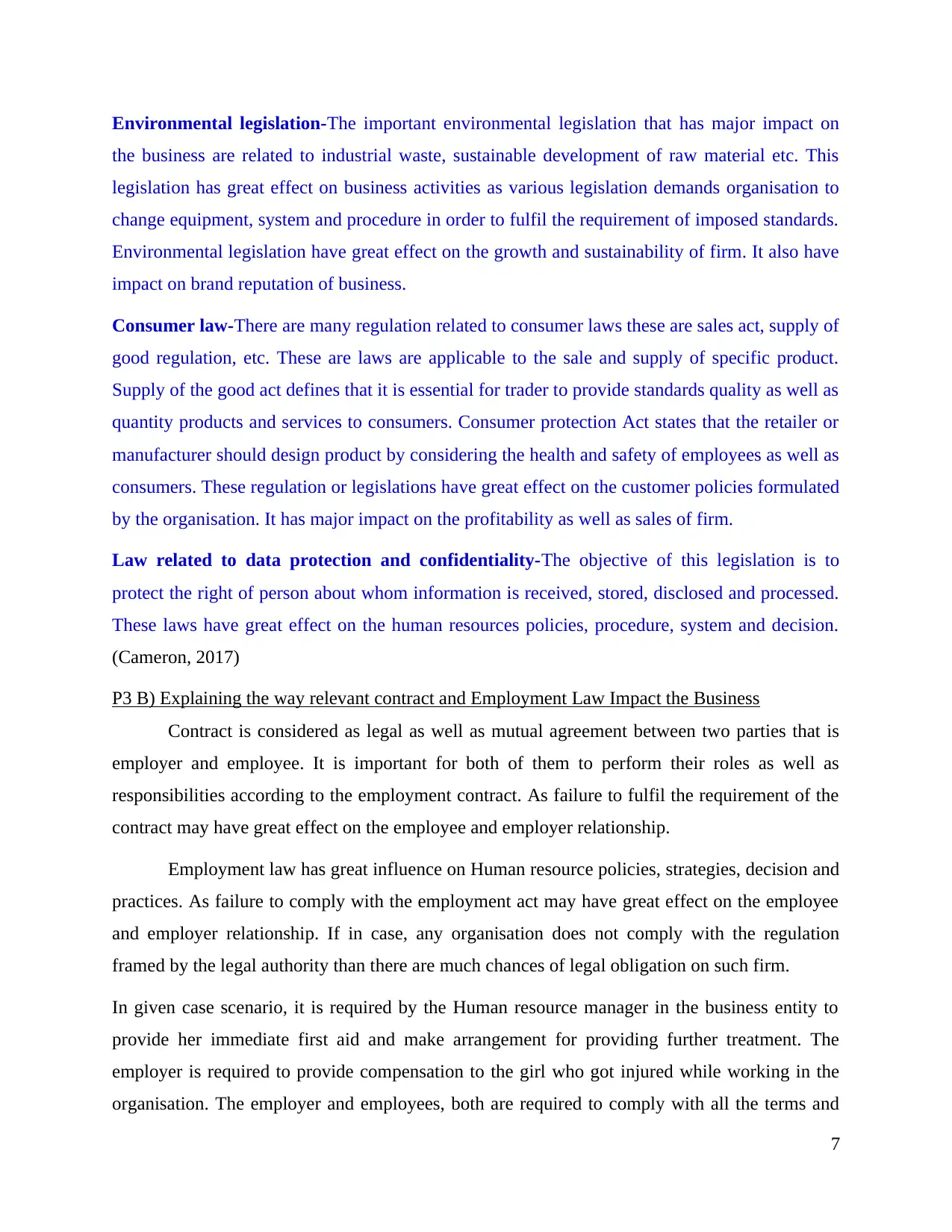
Environmental legislation-The important environmental legislation that has major impact on
the business are related to industrial waste, sustainable development of raw material etc. This
legislation has great effect on business activities as various legislation demands organisation to
change equipment, system and procedure in order to fulfil the requirement of imposed standards.
Environmental legislation have great effect on the growth and sustainability of firm. It also have
impact on brand reputation of business.
Consumer law-There are many regulation related to consumer laws these are sales act, supply of
good regulation, etc. These are laws are applicable to the sale and supply of specific product.
Supply of the good act defines that it is essential for trader to provide standards quality as well as
quantity products and services to consumers. Consumer protection Act states that the retailer or
manufacturer should design product by considering the health and safety of employees as well as
consumers. These regulation or legislations have great effect on the customer policies formulated
by the organisation. It has major impact on the profitability as well as sales of firm.
Law related to data protection and confidentiality-The objective of this legislation is to
protect the right of person about whom information is received, stored, disclosed and processed.
These laws have great effect on the human resources policies, procedure, system and decision.
(Cameron, 2017)
P3 B) Explaining the way relevant contract and Employment Law Impact the Business
Contract is considered as legal as well as mutual agreement between two parties that is
employer and employee. It is important for both of them to perform their roles as well as
responsibilities according to the employment contract. As failure to fulfil the requirement of the
contract may have great effect on the employee and employer relationship.
Employment law has great influence on Human resource policies, strategies, decision and
practices. As failure to comply with the employment act may have great effect on the employee
and employer relationship. If in case, any organisation does not comply with the regulation
framed by the legal authority than there are much chances of legal obligation on such firm.
In given case scenario, it is required by the Human resource manager in the business entity to
provide her immediate first aid and make arrangement for providing further treatment. The
employer is required to provide compensation to the girl who got injured while working in the
organisation. The employer and employees, both are required to comply with all the terms and
7
the business are related to industrial waste, sustainable development of raw material etc. This
legislation has great effect on business activities as various legislation demands organisation to
change equipment, system and procedure in order to fulfil the requirement of imposed standards.
Environmental legislation have great effect on the growth and sustainability of firm. It also have
impact on brand reputation of business.
Consumer law-There are many regulation related to consumer laws these are sales act, supply of
good regulation, etc. These are laws are applicable to the sale and supply of specific product.
Supply of the good act defines that it is essential for trader to provide standards quality as well as
quantity products and services to consumers. Consumer protection Act states that the retailer or
manufacturer should design product by considering the health and safety of employees as well as
consumers. These regulation or legislations have great effect on the customer policies formulated
by the organisation. It has major impact on the profitability as well as sales of firm.
Law related to data protection and confidentiality-The objective of this legislation is to
protect the right of person about whom information is received, stored, disclosed and processed.
These laws have great effect on the human resources policies, procedure, system and decision.
(Cameron, 2017)
P3 B) Explaining the way relevant contract and Employment Law Impact the Business
Contract is considered as legal as well as mutual agreement between two parties that is
employer and employee. It is important for both of them to perform their roles as well as
responsibilities according to the employment contract. As failure to fulfil the requirement of the
contract may have great effect on the employee and employer relationship.
Employment law has great influence on Human resource policies, strategies, decision and
practices. As failure to comply with the employment act may have great effect on the employee
and employer relationship. If in case, any organisation does not comply with the regulation
framed by the legal authority than there are much chances of legal obligation on such firm.
In given case scenario, it is required by the Human resource manager in the business entity to
provide her immediate first aid and make arrangement for providing further treatment. The
employer is required to provide compensation to the girl who got injured while working in the
organisation. The employer and employees, both are required to comply with all the terms and
7
⊘ This is a preview!⊘
Do you want full access?
Subscribe today to unlock all pages.

Trusted by 1+ million students worldwide
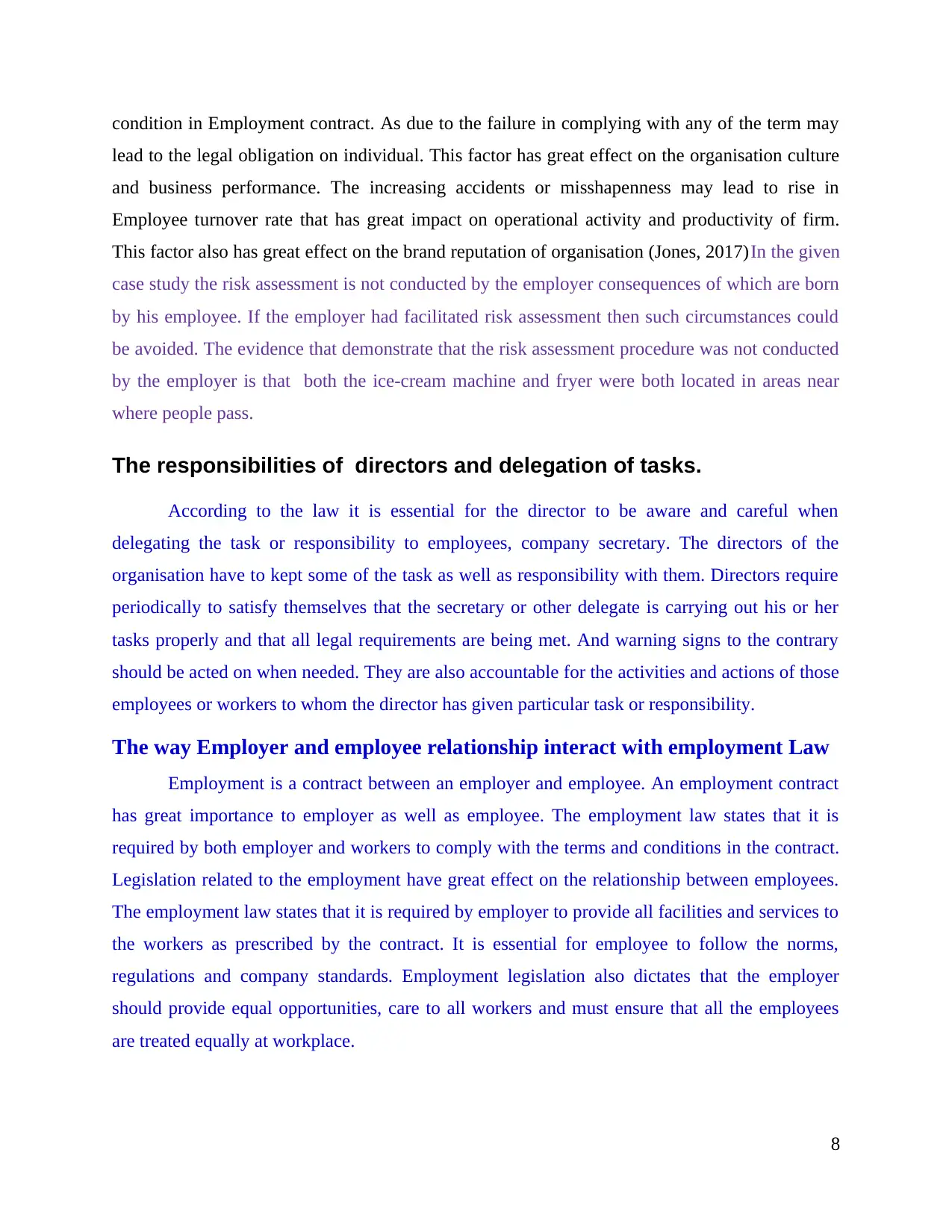
condition in Employment contract. As due to the failure in complying with any of the term may
lead to the legal obligation on individual. This factor has great effect on the organisation culture
and business performance. The increasing accidents or misshapenness may lead to rise in
Employee turnover rate that has great impact on operational activity and productivity of firm.
This factor also has great effect on the brand reputation of organisation (Jones, 2017)In the given
case study the risk assessment is not conducted by the employer consequences of which are born
by his employee. If the employer had facilitated risk assessment then such circumstances could
be avoided. The evidence that demonstrate that the risk assessment procedure was not conducted
by the employer is that both the ice-cream machine and fryer were both located in areas near
where people pass.
The responsibilities of directors and delegation of tasks.
According to the law it is essential for the director to be aware and careful when
delegating the task or responsibility to employees, company secretary. The directors of the
organisation have to kept some of the task as well as responsibility with them. Directors require
periodically to satisfy themselves that the secretary or other delegate is carrying out his or her
tasks properly and that all legal requirements are being met. And warning signs to the contrary
should be acted on when needed. They are also accountable for the activities and actions of those
employees or workers to whom the director has given particular task or responsibility.
The way Employer and employee relationship interact with employment Law
Employment is a contract between an employer and employee. An employment contract
has great importance to employer as well as employee. The employment law states that it is
required by both employer and workers to comply with the terms and conditions in the contract.
Legislation related to the employment have great effect on the relationship between employees.
The employment law states that it is required by employer to provide all facilities and services to
the workers as prescribed by the contract. It is essential for employee to follow the norms,
regulations and company standards. Employment legislation also dictates that the employer
should provide equal opportunities, care to all workers and must ensure that all the employees
are treated equally at workplace.
8
lead to the legal obligation on individual. This factor has great effect on the organisation culture
and business performance. The increasing accidents or misshapenness may lead to rise in
Employee turnover rate that has great impact on operational activity and productivity of firm.
This factor also has great effect on the brand reputation of organisation (Jones, 2017)In the given
case study the risk assessment is not conducted by the employer consequences of which are born
by his employee. If the employer had facilitated risk assessment then such circumstances could
be avoided. The evidence that demonstrate that the risk assessment procedure was not conducted
by the employer is that both the ice-cream machine and fryer were both located in areas near
where people pass.
The responsibilities of directors and delegation of tasks.
According to the law it is essential for the director to be aware and careful when
delegating the task or responsibility to employees, company secretary. The directors of the
organisation have to kept some of the task as well as responsibility with them. Directors require
periodically to satisfy themselves that the secretary or other delegate is carrying out his or her
tasks properly and that all legal requirements are being met. And warning signs to the contrary
should be acted on when needed. They are also accountable for the activities and actions of those
employees or workers to whom the director has given particular task or responsibility.
The way Employer and employee relationship interact with employment Law
Employment is a contract between an employer and employee. An employment contract
has great importance to employer as well as employee. The employment law states that it is
required by both employer and workers to comply with the terms and conditions in the contract.
Legislation related to the employment have great effect on the relationship between employees.
The employment law states that it is required by employer to provide all facilities and services to
the workers as prescribed by the contract. It is essential for employee to follow the norms,
regulations and company standards. Employment legislation also dictates that the employer
should provide equal opportunities, care to all workers and must ensure that all the employees
are treated equally at workplace.
8
Paraphrase This Document
Need a fresh take? Get an instant paraphrase of this document with our AI Paraphraser
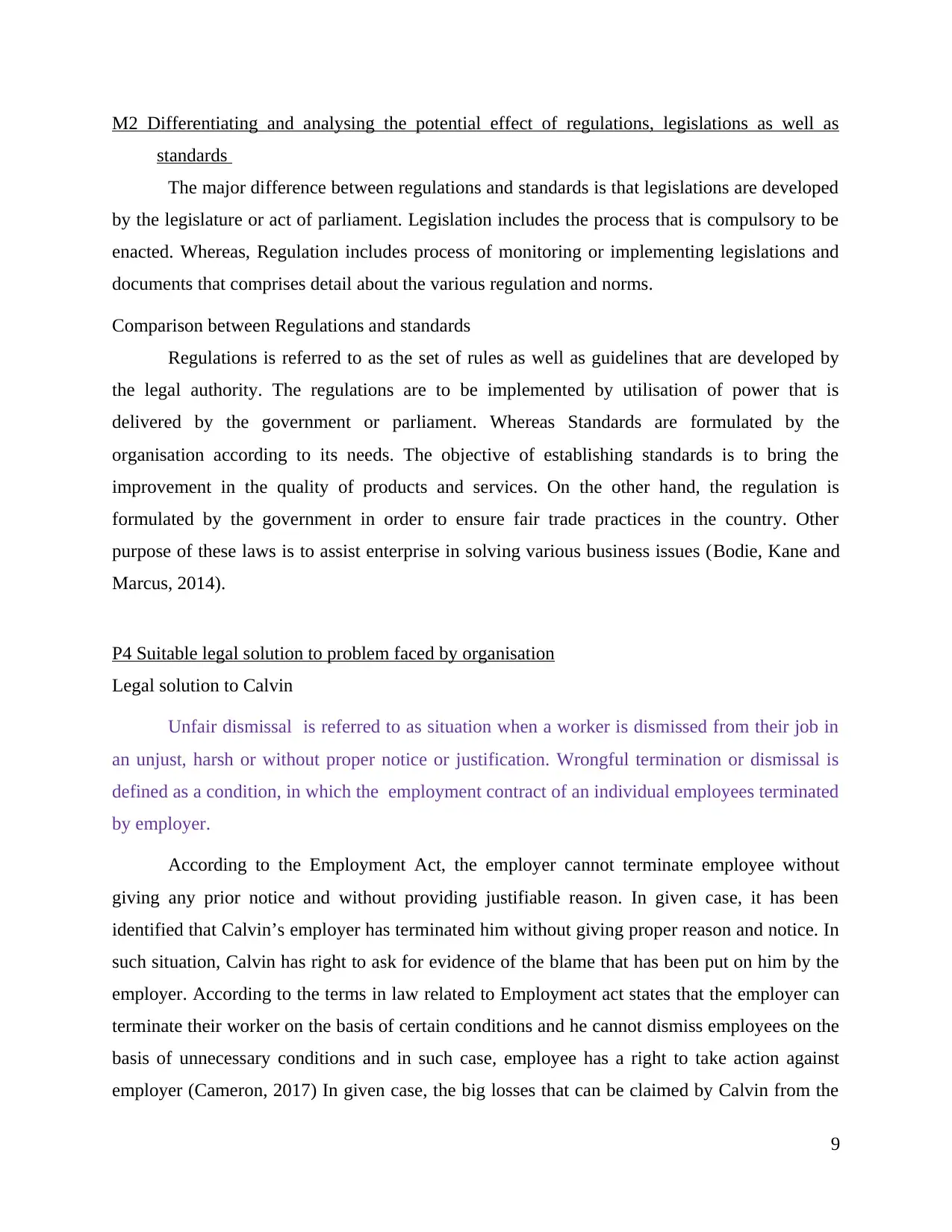
M2 Differentiating and analysing the potential effect of regulations, legislations as well as
standards
The major difference between regulations and standards is that legislations are developed
by the legislature or act of parliament. Legislation includes the process that is compulsory to be
enacted. Whereas, Regulation includes process of monitoring or implementing legislations and
documents that comprises detail about the various regulation and norms.
Comparison between Regulations and standards
Regulations is referred to as the set of rules as well as guidelines that are developed by
the legal authority. The regulations are to be implemented by utilisation of power that is
delivered by the government or parliament. Whereas Standards are formulated by the
organisation according to its needs. The objective of establishing standards is to bring the
improvement in the quality of products and services. On the other hand, the regulation is
formulated by the government in order to ensure fair trade practices in the country. Other
purpose of these laws is to assist enterprise in solving various business issues (Bodie, Kane and
Marcus, 2014).
P4 Suitable legal solution to problem faced by organisation
Legal solution to Calvin
Unfair dismissal is referred to as situation when a worker is dismissed from their job in
an unjust, harsh or without proper notice or justification. Wrongful termination or dismissal is
defined as a condition, in which the employment contract of an individual employees terminated
by employer.
According to the Employment Act, the employer cannot terminate employee without
giving any prior notice and without providing justifiable reason. In given case, it has been
identified that Calvin’s employer has terminated him without giving proper reason and notice. In
such situation, Calvin has right to ask for evidence of the blame that has been put on him by the
employer. According to the terms in law related to Employment act states that the employer can
terminate their worker on the basis of certain conditions and he cannot dismiss employees on the
basis of unnecessary conditions and in such case, employee has a right to take action against
employer (Cameron, 2017) In given case, the big losses that can be claimed by Calvin from the
9
standards
The major difference between regulations and standards is that legislations are developed
by the legislature or act of parliament. Legislation includes the process that is compulsory to be
enacted. Whereas, Regulation includes process of monitoring or implementing legislations and
documents that comprises detail about the various regulation and norms.
Comparison between Regulations and standards
Regulations is referred to as the set of rules as well as guidelines that are developed by
the legal authority. The regulations are to be implemented by utilisation of power that is
delivered by the government or parliament. Whereas Standards are formulated by the
organisation according to its needs. The objective of establishing standards is to bring the
improvement in the quality of products and services. On the other hand, the regulation is
formulated by the government in order to ensure fair trade practices in the country. Other
purpose of these laws is to assist enterprise in solving various business issues (Bodie, Kane and
Marcus, 2014).
P4 Suitable legal solution to problem faced by organisation
Legal solution to Calvin
Unfair dismissal is referred to as situation when a worker is dismissed from their job in
an unjust, harsh or without proper notice or justification. Wrongful termination or dismissal is
defined as a condition, in which the employment contract of an individual employees terminated
by employer.
According to the Employment Act, the employer cannot terminate employee without
giving any prior notice and without providing justifiable reason. In given case, it has been
identified that Calvin’s employer has terminated him without giving proper reason and notice. In
such situation, Calvin has right to ask for evidence of the blame that has been put on him by the
employer. According to the terms in law related to Employment act states that the employer can
terminate their worker on the basis of certain conditions and he cannot dismiss employees on the
basis of unnecessary conditions and in such case, employee has a right to take action against
employer (Cameron, 2017) In given case, the big losses that can be claimed by Calvin from the
9
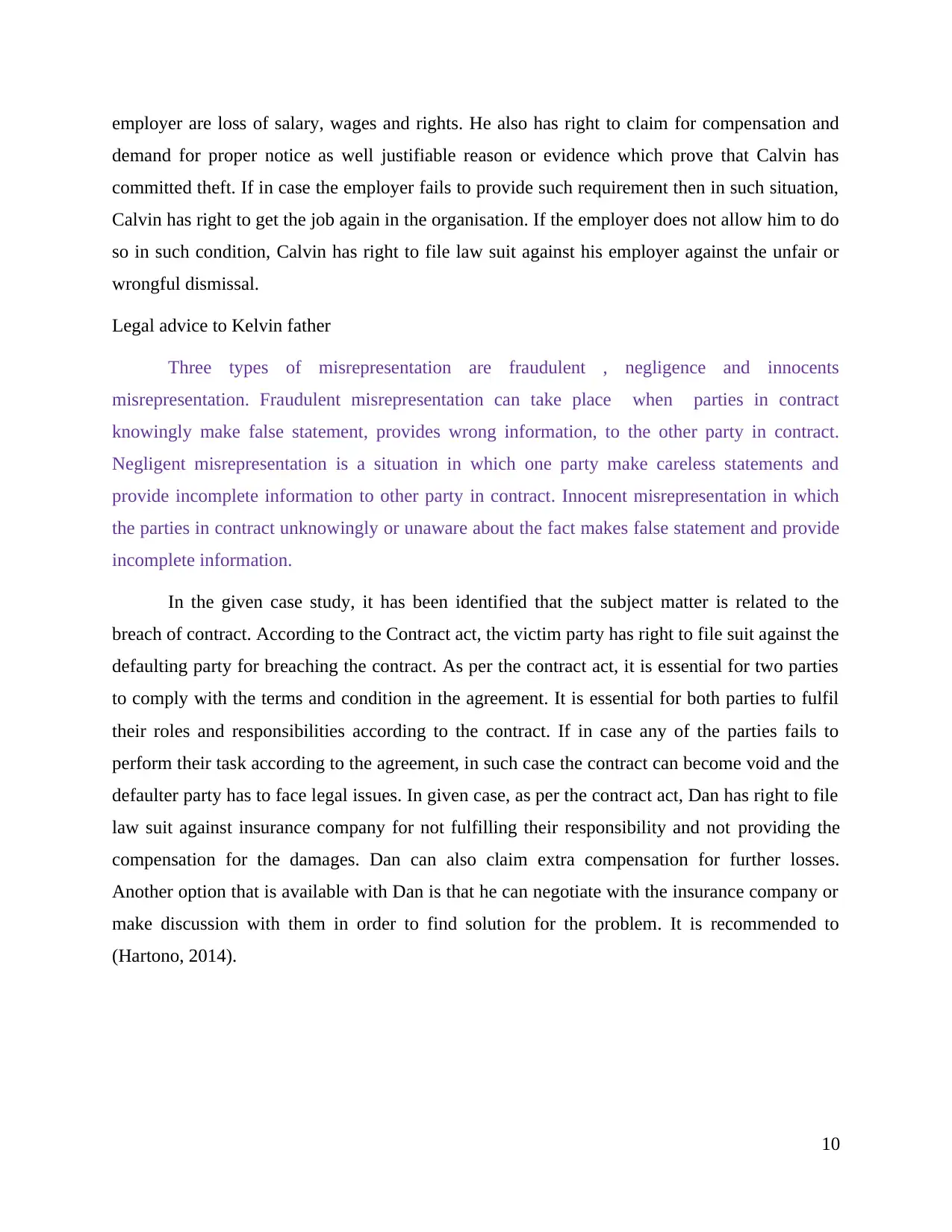
employer are loss of salary, wages and rights. He also has right to claim for compensation and
demand for proper notice as well justifiable reason or evidence which prove that Calvin has
committed theft. If in case the employer fails to provide such requirement then in such situation,
Calvin has right to get the job again in the organisation. If the employer does not allow him to do
so in such condition, Calvin has right to file law suit against his employer against the unfair or
wrongful dismissal.
Legal advice to Kelvin father
Three types of misrepresentation are fraudulent , negligence and innocents
misrepresentation. Fraudulent misrepresentation can take place when parties in contract
knowingly make false statement, provides wrong information, to the other party in contract.
Negligent misrepresentation is a situation in which one party make careless statements and
provide incomplete information to other party in contract. Innocent misrepresentation in which
the parties in contract unknowingly or unaware about the fact makes false statement and provide
incomplete information.
In the given case study, it has been identified that the subject matter is related to the
breach of contract. According to the Contract act, the victim party has right to file suit against the
defaulting party for breaching the contract. As per the contract act, it is essential for two parties
to comply with the terms and condition in the agreement. It is essential for both parties to fulfil
their roles and responsibilities according to the contract. If in case any of the parties fails to
perform their task according to the agreement, in such case the contract can become void and the
defaulter party has to face legal issues. In given case, as per the contract act, Dan has right to file
law suit against insurance company for not fulfilling their responsibility and not providing the
compensation for the damages. Dan can also claim extra compensation for further losses.
Another option that is available with Dan is that he can negotiate with the insurance company or
make discussion with them in order to find solution for the problem. It is recommended to
(Hartono, 2014).
10
demand for proper notice as well justifiable reason or evidence which prove that Calvin has
committed theft. If in case the employer fails to provide such requirement then in such situation,
Calvin has right to get the job again in the organisation. If the employer does not allow him to do
so in such condition, Calvin has right to file law suit against his employer against the unfair or
wrongful dismissal.
Legal advice to Kelvin father
Three types of misrepresentation are fraudulent , negligence and innocents
misrepresentation. Fraudulent misrepresentation can take place when parties in contract
knowingly make false statement, provides wrong information, to the other party in contract.
Negligent misrepresentation is a situation in which one party make careless statements and
provide incomplete information to other party in contract. Innocent misrepresentation in which
the parties in contract unknowingly or unaware about the fact makes false statement and provide
incomplete information.
In the given case study, it has been identified that the subject matter is related to the
breach of contract. According to the Contract act, the victim party has right to file suit against the
defaulting party for breaching the contract. As per the contract act, it is essential for two parties
to comply with the terms and condition in the agreement. It is essential for both parties to fulfil
their roles and responsibilities according to the contract. If in case any of the parties fails to
perform their task according to the agreement, in such case the contract can become void and the
defaulter party has to face legal issues. In given case, as per the contract act, Dan has right to file
law suit against insurance company for not fulfilling their responsibility and not providing the
compensation for the damages. Dan can also claim extra compensation for further losses.
Another option that is available with Dan is that he can negotiate with the insurance company or
make discussion with them in order to find solution for the problem. It is recommended to
(Hartono, 2014).
10
⊘ This is a preview!⊘
Do you want full access?
Subscribe today to unlock all pages.

Trusted by 1+ million students worldwide
1 out of 18
Related Documents
Your All-in-One AI-Powered Toolkit for Academic Success.
+13062052269
info@desklib.com
Available 24*7 on WhatsApp / Email
![[object Object]](/_next/static/media/star-bottom.7253800d.svg)
Unlock your academic potential
Copyright © 2020–2026 A2Z Services. All Rights Reserved. Developed and managed by ZUCOL.





